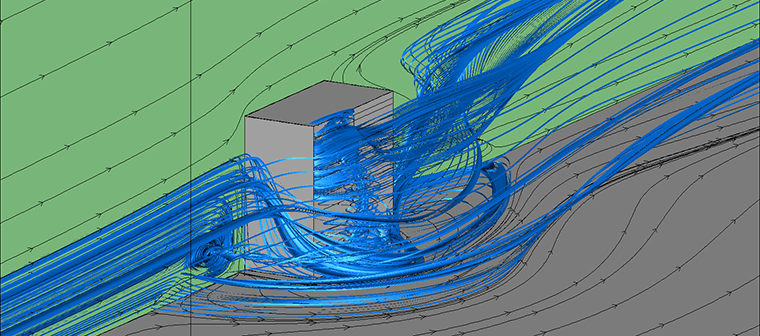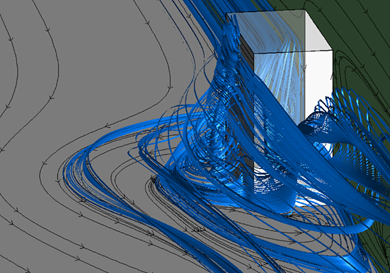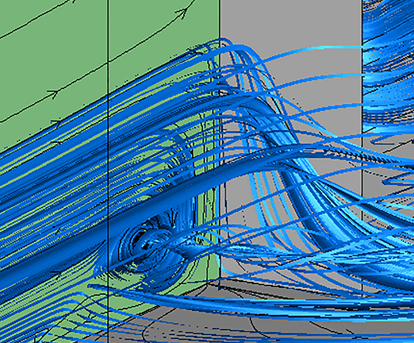Researchers at U.S. Naval Academy and George Mason University use Tecplot 360 to clearly visualize horseshoe vortices in flow over wall mounted cube for first time.
If you’ve ever stood on a beach and felt the sandy surface collapse beneath your feet as the waves washed over them, you’ve experienced firsthand the powerful effects of fluid flow. When the waves meet the surface boundaries commonly called your toes and feet, they generate vortices that create shear, which whisks the sand particles away. Meanwhile, your feet are left to sink slowly into the sand. It’s an enchanting pastime to observe this phenomena on a summer day. But these forces also cause serious problems for those who need to ensure the integrity of structures that are subjected to the fluid dynamics of water, wind, and other materials that flow.
“One example might be a bridge with support columns embedded in a river, lake, or sea bed. If the columns have a square cross-section, the ability to clearly visualize horseshoe vortices would help engineers immensely in determining how to best battle deformation of the columns. The same would apply to aircraft, many of which have box-like protrusions, especially under the wing. The more we can minimize deformation, the better.”
– Anastasios Liakos researcher with the Department of Mathematics at the U.S. Naval Academy in Annapolis, Maryland.

Figure 1. Researchers have clearly visualized horseshoe vortices in study of flow around surface mounted cube in 3D channel flow for moderate Reynolds numbers. The study also showed tornado-like vortices on side of cube for all Reynolds numbers.
Building on the work of many researchers who have been studying fluid flow over the last 30 years, Liakos and his colleague Nikolaos A. Malamataris at the School of Physics, Astronomy, and Computational Sciences at George Mason University in Fairfax, Virginia, recently took this research one step farther by clearly visualizing a horseshoe vortex in an actual 3D image for the first time.
“Other researchers have visualized these vortices, but they weren’t clear – you knew they were there but there was not enough resolution to be useful for engineering design. And clarity is essential because flow around a cube generates such complicated structures,” says Liakos. “Without those first efforts, though, we wouldn’t have been able to do this study. This was just the next step.”
– Liakos
Flow Under Creeping Conditions Studied
Figure 2 shows a close-up of the right half of a horseshoe vortex formed upstream from a wall mounted cube. For the first time in a computational study, this vortex is shown in an actual three dimensional image. A step by step study of the pressure and critical points along the plane of symmetry showed that the existent adverse pressure gradient, which appears at creeping flow conditions, needs to acquire a certain magnitude in order for the horseshoe vortex to appear. The horseshoe vortex appears at Reynolds number 1266.
Malamataris and Liakos found that a tornado-like vortex on the side of cube was present for all Reynolds numbers for which flow was simulated, as shown in Figure 3. The vortex appears because of the dihedral angle that is formed between the side of the cube and bottom wall of the channel. As the Reynolds number increases, the shape of this vortex becomes twisted due to the increased shear.

Figure 3.
To gain a basic understanding of fluid mechanics in three dimensions, Malamataris and Liakos needed to study the flow under creeping conditions and in the whole range of laminar flow. This meant examining the three dimensional flow across a wide range of low to moderate Reynolds numbers.
They ran the numerical simulations using a custom parallel finite element code. The computational domain was designed according to actual laboratory experiment conditions, and analysis of the results were performed using the three dimensional theory of separation. The last step was to import it into Tecplot 360.
Technical Support
“I can’t say enough good things about the tech support at Tecplot. This [Tecplot 360] is a robust and sophisticated software program that can do amazing things. But if you don’t use certain features on a regular basis, you can get rusty and even may forget a feature is there. I knew what we wanted to do, I knew Tecplot 360 could do it, but I needed to refresh my knowledge. When I called tech support, they were very gracious, knew exactly what I was talking about, and showed me how to visualize our results efficiently and accurately. It was great.”
– Liakos
Effects of Temperature and Time
This is just the beginning of Liakos and Malamataris’ collaboration. The researchers plan to examine other parameters related to flow over a wall mounted cube, including the effect of temperature, time, and non-symmetrical boundaries.
“Shearing affects temperatures around the object. Wide variations in temperatures can cause issues, and you want to make sure the material and design can handle it.
“If it weren’t for Tecplot, I couldn’t do this stuff.”– Liakos





